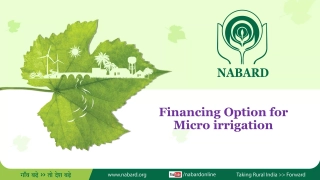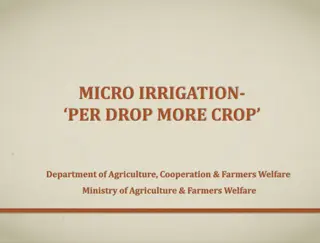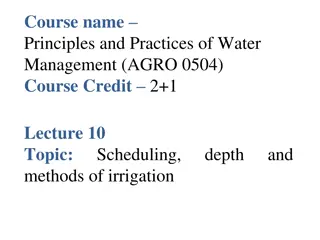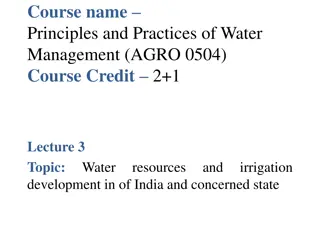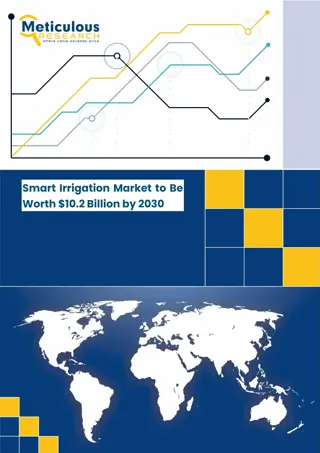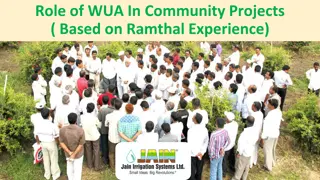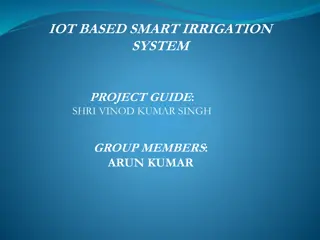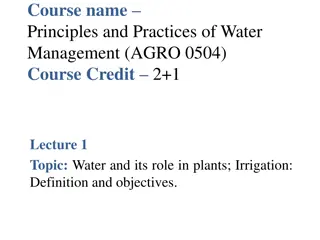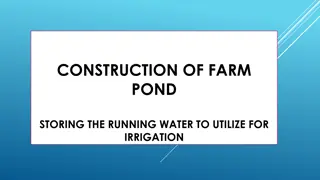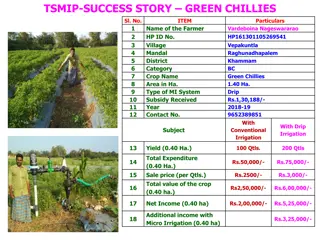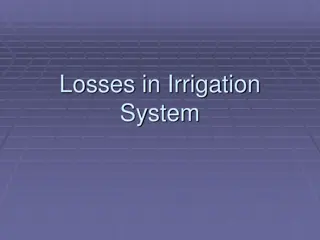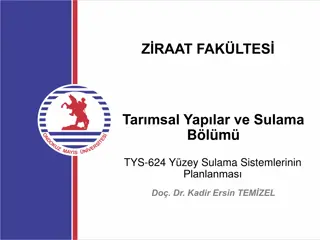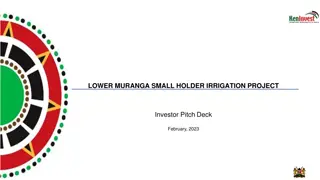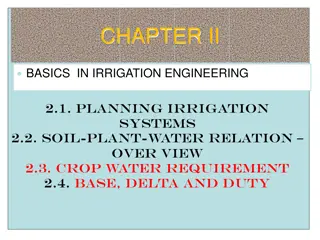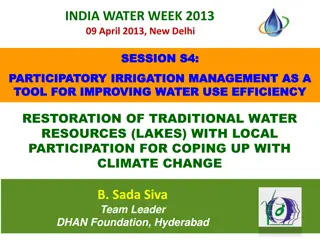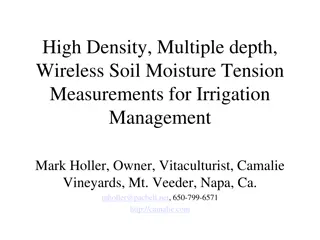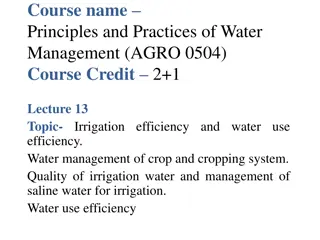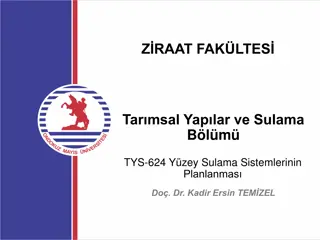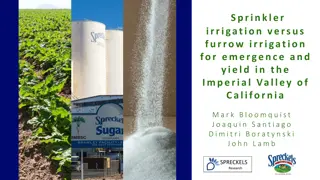Comprehensive Guide to Irrigation in Agriculture
Irrigation plays a crucial role in agriculture, enhancing crop quality, increasing yields, and driving global food production. This guide covers the benefits, needs, and water quality-related problems associated with irrigation in agriculture, emphasizing its importance in sustaining food supply and addressing challenges such as salinity, water infiltration rate, specific ion toxicity, and microbial contamination.
Download Presentation

Please find below an Image/Link to download the presentation.
The content on the website is provided AS IS for your information and personal use only. It may not be sold, licensed, or shared on other websites without obtaining consent from the author.If you encounter any issues during the download, it is possible that the publisher has removed the file from their server.
You are allowed to download the files provided on this website for personal or commercial use, subject to the condition that they are used lawfully. All files are the property of their respective owners.
The content on the website is provided AS IS for your information and personal use only. It may not be sold, licensed, or shared on other websites without obtaining consent from the author.
E N D
Presentation Transcript
Irrigation The artificial application of water to the land or soil. Used to: assist in the growing of agricultural crops, protecting plants against frost, suppressing weed growth in grain fields preventing soil consolidation. maintenance of landscapes, Re-vegetation of disturbed soils in dry areas SHOULD ALWAYS BE ASSESSED TOGETHER WITH DRAINAGE
Irrigation & Agriculture Irrigated agriculture has driven much of the increase in global food production over recent decades. While only 20% of the world's farmland is irrigated, it produces 40% of our food supply. Highest yields obtained from irrigation are more than double the highest yields from rainfed agriculture (FAO report).
Benefits of Irrigation Improving crop quality - most noticeable for vegetable crops. Effective management of crop water needs supply water as needed. Planned agriculture Improved economics of farming Significantly increasing crop yields particularly on sandy soils which have low moisture-holding capacities. Increasing opportunities for double cropping. Providing a means of liquid fertilizer application. Possible reduction in fertiliser use Reduction in production cost
Irrigation Needs Irrigated agriculture is dependent on an adequate water supply of usable quality Quality not normally paramount in Jamaica Availability of adequate good supply No real need to meet standards Impact of development on ground water and surface water causing concern Need for global trade Reduced availability of water Competition for water
WATER QUALITY-RELATED PROBLEMS IN IRRIGATED AGRICULTURE SALINITY Salts in soil or water reduce water availability to the crop to such an extent that yield is affected. WATER INFILTRATION RATE Relatively high sodium or low calcium content of soil or water reduces the rate at which irrigation water enters soil to such an extent that sufficient water cannot be infiltrated to supply the crop adequately from one irrigation to the next. SPECIFIC ION TOXICITY Certain ions (sodium, chloride, or boron) from soil or water accumulate in a sensitive crop to concentrations high enough to cause crop damage and reduce yields. MISCELLANEOUS Excessive nutrients reduce yield or quality; unsightly deposits on fruit or foliage reduce marketability; excessive corrosion of equipment increases maintenance and repairs. MICROBIAL CONTAMINATION air, soils and plants in the vicinity of the irrigation site
Concerns for Effluent Re-use In quantitative terms, the volume of wastewater available for re-use by irrigated agriculture is negligible when compared with the overall volume of water used for irrigation. The potential impacts associated with water quality and agricultural re-use of wastewater are important economically, environmentally and socially, Sound planning needs far exceeds the relatively small quantities and areas involved Global GAP Certification
Recommendations microbial and biochemical properties will have to be evaluated. values should then be compared with the public health standards, consideration of the crop, soil and irrigation system and consumption of the produce only when the effluent meets these standards should it be evaluated in terms of chemical criteria such as dissolved salts, relative sodium content and specific toxic ions
Irrigation Infrastructure Irrigation Schemes Pump Stations Wells Canals Pipes (km) Rio Cobre 18 22 26 31.01 St. Dorothy 8 7 28 - Yallahs 3 3 - 15.21 Mid- 32 32 153 36.10 Clarendon New Forest 2 4 - 26 Hounslow 5 5 - 41.40 Beacon/Little Park 3 3 - 27.83 Seven Rivers - 1 - 2.96 Colbeck 1 1 - 8.60 Braco 1 1 - 8.60 Grand Total 73 79 207 194.24
What Happens Elsewhere California Primaryeffluent; no spray irrigation Primary effluent; spray irrigation Israel Secondaryefflue nt South Africa Tertiary effluent, chlorination, No spray irrigation Tertiary effluent Pretreatment FR Germany No spray irrigation in the vicinity Orchards and vineyards Fodder fibre crops and seed crops Secondary effluent, use on edible vegetables not permitted Vegetables for human consumption 1000 coliform organisms per 100 ml in 80% of samples) Not to be irrigated with renovated wastewater unless they consist of fruits that are peeled with screening and settling tanks. Crops for human consumption that will be processed to kill pathogens For spray no more than 23 coliform organisms per 100 ml. Tertiary effluent Irrigation up to 4 weeks before harvesting only Crops for human consumption in a raw state For surface irrigation, no more than 2.2 coliform organisms per 100 ml. Potatoes and cereals - irrigation through flowering stage only
Further Recommendation Culture change initiative Farmers are presently averse to the re-use Public Consultations/Public Education Campaign Develop capacity of treatment facility to maintain constant effluent quality Long-term monitoring data to substantiate Contingencies for emergency management Develop nutrient management capacity to manage soil impact of treated effluent. Full re-use of waste is recommended Waste to energy Fertilizer development


